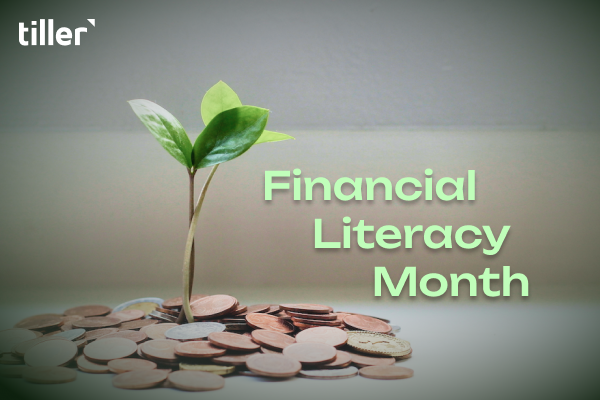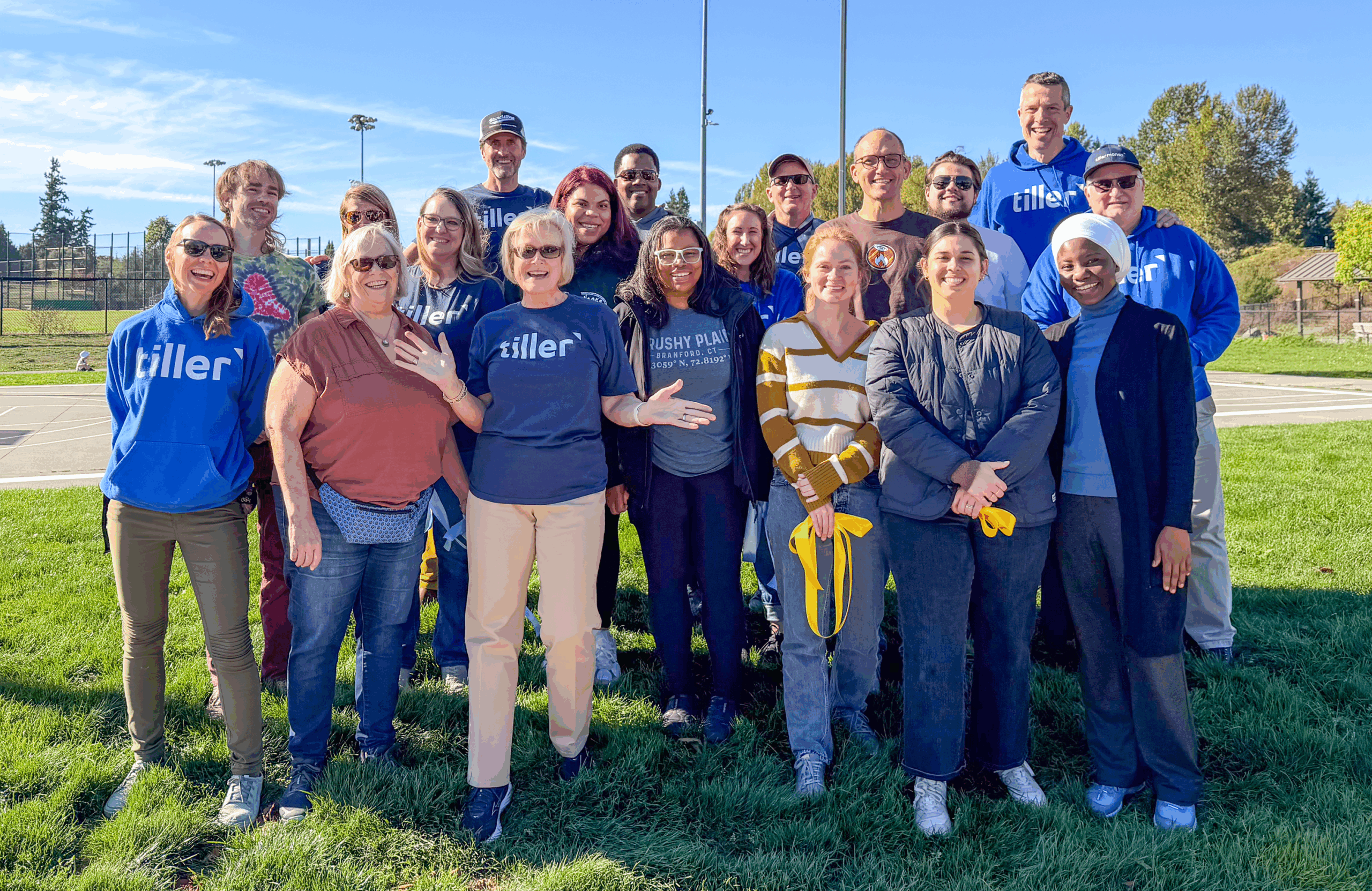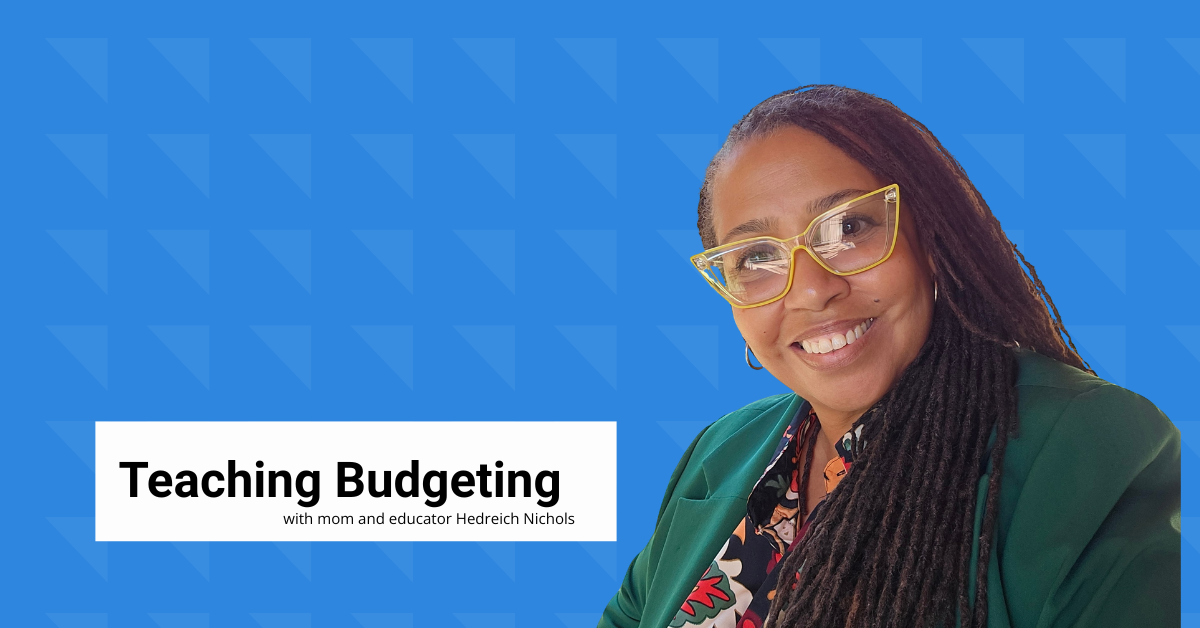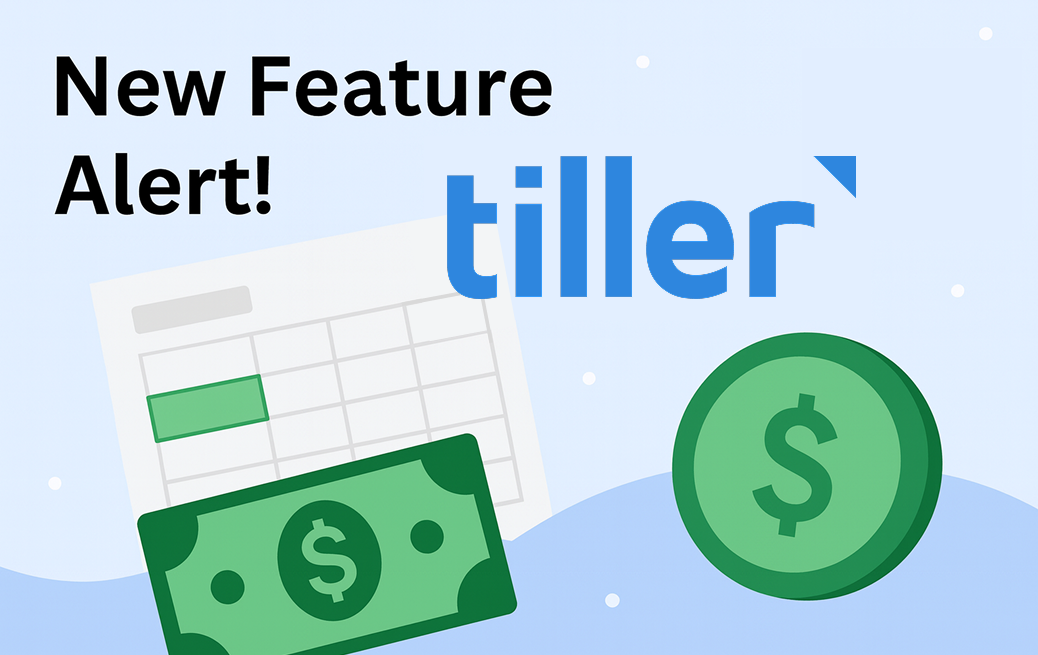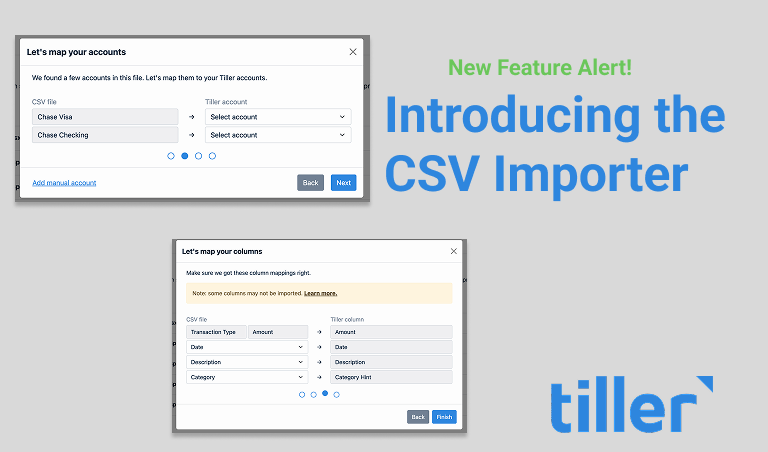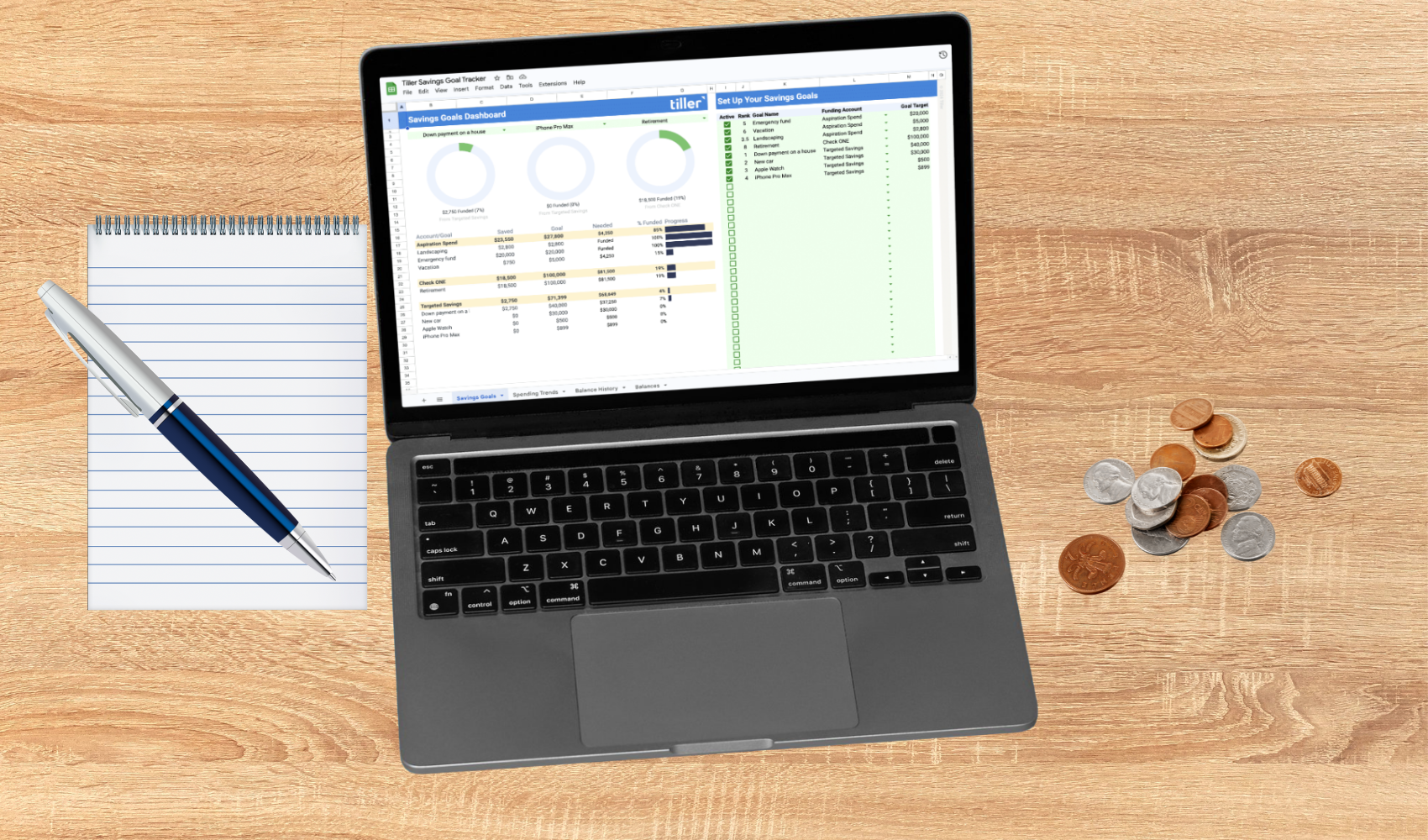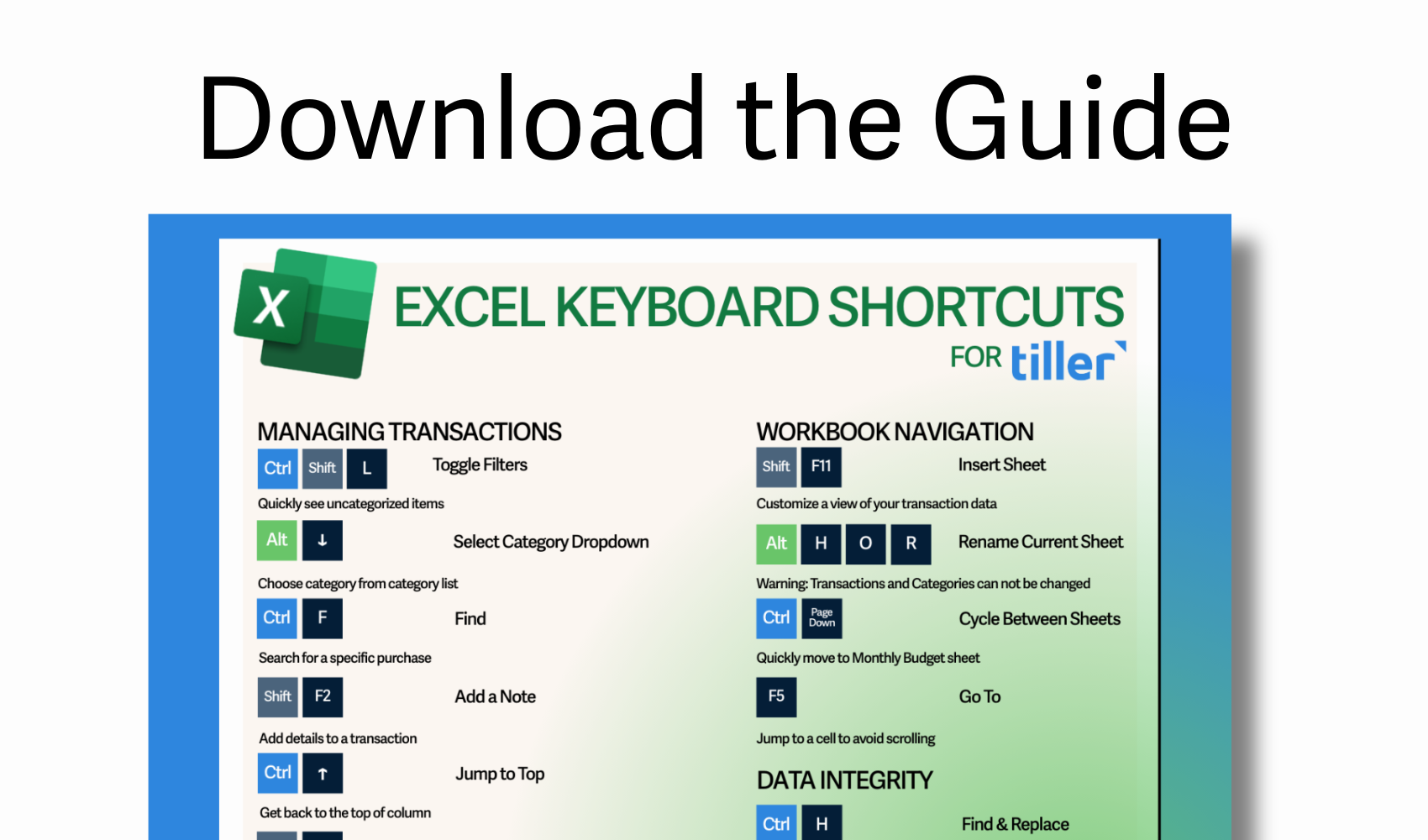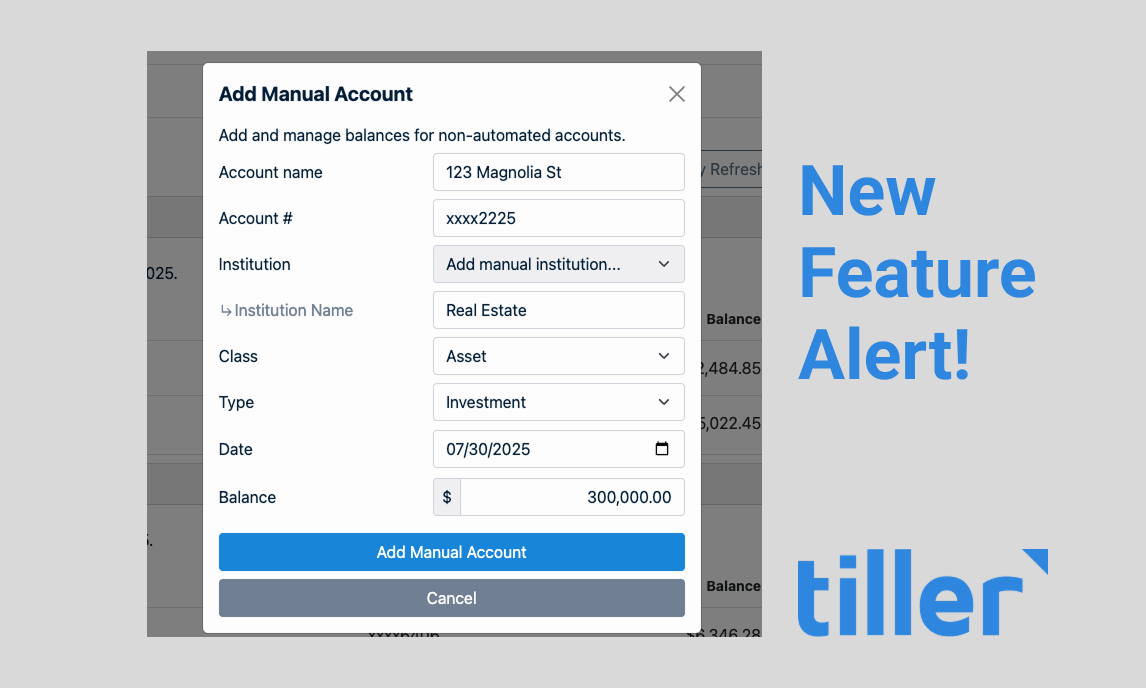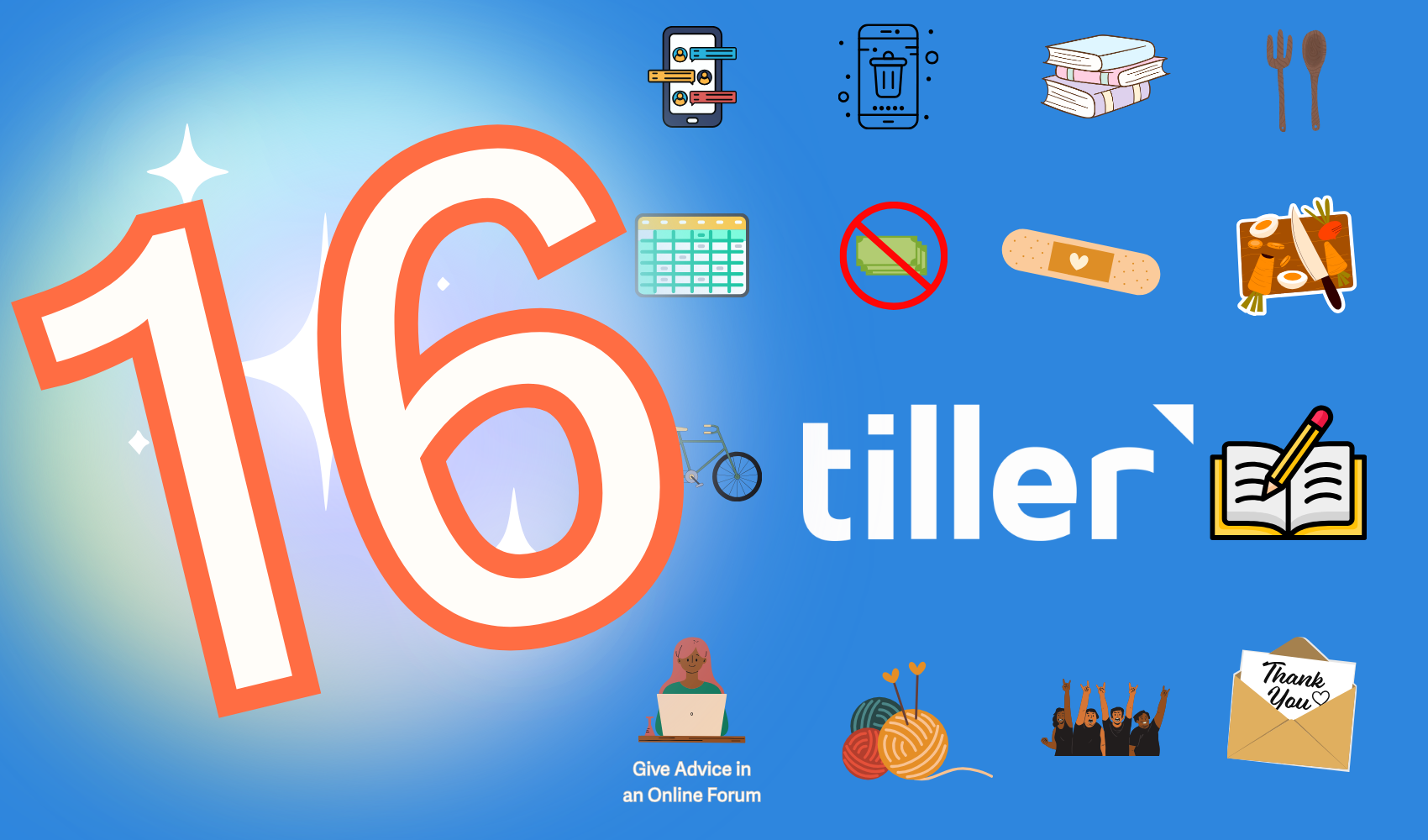April is Financial Literacy Month, a time to focus on the financial knowledge and skills that help people build stable, confident lives. Studies show that nearly 50% of adults lack basic financial literacy. At Tiller, we believe that everyone deserves access to clear, practical money knowledge.
Before you dive into this guide, take our short quiz to see how your current skills stack up.

Digital financial tools are now part of daily life. From app-based spending to online banking and subscriptions, money flows through digital channels. Knowing how to use these tools responsibly is part of modern financial literacy. It also means being aware of risks like scams, overspending, and privacy threats. Tools like Tiller help people stay on top of their finances by providing automatic updates and a clear view of spending trends.
Financial literacy has become such a vital area of research that it now has its own classification within the Journal of Economic Literature (G53) (Lusardi & Mitchell, 2013). Even with this recognition, the general level of financial understanding remains unacceptably low. Research consistently shows that “financial literacy is low and often inadequate for making the types of financial decisions that are required today” (Lusardi & Mitchell, 2013; Lusardi & Messy, 2023).
This lack of knowledge is particularly evident among students and groups considered more financially vulnerable. Women, individuals with lower incomes, and those with limited access to financial education tend to show especially low levels of financial literacy (Lusardi & Mitchell, 2013; FMIR, 2023).
We’ve created a list of 100 essential financial skills every adult should know.

Core Financial Foundations
1. Understand the Difference Between Assets and Liabilities
Assets, such as savings, investments, and property, add value to your financial life. Liabilities are debts like loans and credit card balances. Focus on increasing assets while minimizing liabilities to grow your net worth.
2. Know How Compound Interest Works
Compound interest earns money on both your original deposit and the interest it accumulates. It helps your savings and investments grow faster over time. Use this to your advantage by starting early and contributing consistently.
3. Recognize the Importance of an Emergency Fund
Build an emergency fund to cover unexpected expenses like medical bills or car repairs. Aim for three to six months of living expenses in a separate savings account. This safety net helps you avoid going into debt during tough times.
4. Understand How Credit Scores Are Calculated
Your credit score reflects how reliably you repay debt, based on factors like payment history, credit utilization, length of credit history, new credit, and credit mix. Lenders use credit scores to assess risk when issuing loans or credit.
5. Know How to Read a Credit Report
A credit report is a detailed record of your credit history. You should review it regularly to check for errors, identify potential fraud, and monitor your credit health.
6. Learn the Basics of Inflation and Purchasing Power
Inflation increases prices over time and decreases the value of money. If your income doesn’t grow with inflation, your purchasing power shrinks. Tiller can help track spending over time so you see how inflation impacts your finances.
7. Understand the Time Value of Money
The time value of money is the concept that money available at the present time is worth more than an identical sum in the future due to its potential earning capacity. This principle is fundamental to financial planning, investment analysis, and loan calculations.
8. Grasp the Basics of Supply and Demand in Personal Finance
Supply and demand influence various aspects of personal finance, such as interest rates (the “price” of borrowing money), investment prices, and the cost of consumer goods and services.
9. Know What “Net Worth” Means and How to Calculate It
Net worth is calculated by subtracting your total liabilities (debts) from your total assets (what you own). Assets include cash, investments, and valuables, while liabilities include mortgages and loans. A positive net worth indicates financial stability, while a negative net worth may require attention. Tiller simplifies net-worth tracking by automatically aggregating your financial data, allowing you to monitor your financial health and make informed decisions.
10. Understand the Concept of Opportunity Cost
Opportunity cost is the potential benefit you give up when choosing one alternative over another. For example, the opportunity cost of spending money on a vacation might be the potential return you could have earned by investing that money.

Budgeting & Cash Flow
11. Track Every Transaction
Meticulously recording all income and expenses provides a detailed understanding of your cash-flow patterns. This practice enables you to identify areas where you can reduce spending, optimize savings, and make informed financial decisions. Tiller simplifies this process by automatically importing transactions from your accounts.
12. Know How to Create and Adjust a Monthly Budget
A budget is a financial plan that outlines your expected income and expenses over a specific period, typically a month. Creating a budget involves allocating funds for various categories, such as housing, food, transportation, and savings. Regularly reviewing and adjusting your budget is essential to ensure it aligns with your changing financial circumstances and goals. Tiller can help you budget, customized to the way you like.
13. Use Budgeting Categories That Fit Your Lifestyle
Customize your budget categories to reflect your individual spending habits and priorities. Common categories include housing, transportation, food, entertainment, and savings, but you may need to add or modify categories to accurately track your spending. Use Tiller to define your budget and compare your monthly spending against your budget.
14. Distinguish Between Fixed and Variable Expenses
Fixed expenses are costs that remain relatively constant from month to month, such as rent, mortgage payments, and loan payments. Variable expenses, on the other hand, fluctuate depending on usage. These include things such as groceries, utilities, and entertainment. Understanding this distinction helps you create a more predictable and manageable budget.
15. Automate Tracking to Stay Consistent
Automating your transaction tracking with tools like Tiller can significantly improve accuracy and consistency. By automatically importing transactions from your bank and credit card accounts, you can eliminate manual data entry and ensure that your budget reflects your most up-to-date financial activity.
16. Learn How to Do Zero-Based Budgeting
Zero-based budgeting is a budgeting method where every dollar of your income is assigned a specific purpose, whether it’s for spending, saving, or debt repayment. The goal is to allocate all of your income so that your income minus your outgo equals zero.
17. Understand Envelope Budgeting
Envelope budgeting is a cash-based budgeting method where you allocate cash to different envelopes for specific spending categories. While less common in the digital age, it can be a helpful technique for individuals who struggle with overspending.
18. Account for Irregular Income or Gig Work
If you have irregular income or work in the gig economy, you need to adjust your budgeting approach. This might involve setting aside a portion of your income during high-earning periods to cover expenses during low-earning periods.
19. Know How to Cut Expenses Without Depriving Yourself
Reducing expenses doesn’t necessarily mean sacrificing your quality of life. Identify nonessential spending and look for ways to save money without depriving yourself of things you enjoy. This could involve cooking more meals at home, finding free entertainment options, or negotiating better deals on services.
20. Periodically Audit Your Subscriptions and Recurring Charges
Regularly review your subscriptions and recurring charges to identify any services you no longer use or need. Canceling unused subscriptions can free up significant funds in your budget. Tiller can help you identify these recurring charges by categorizing your expenses.

Credit & Debt Management
21. Understand APR vs. APY
APR (annual percentage rate) is the annual rate of interest charged on a loan, while APY (annual percentage yield) is the actual rate of return earned on an investment, taking into account the effect of compounding. When comparing loan offers, focus on the APR; when comparing investment options, consider the APY.
22. Know How to Compare Credit Card Offers
When evaluating credit card offers, consider factors such as the APR, annual fees, rewards programs, sign-up bonuses, and other benefits. Choose a card that aligns with your spending habits and financial goals.
23. Recognize Signs of Unhealthy Debt
Signs of unhealthy debt include consistently carrying a high balance on your credit cards, making only minimum payments, using credit to pay for basic necessities, and having a high debt-to-income ratio.
24. Understand Snowball vs. Avalanche Debt Repayment
The debt snowball method involves paying off the smallest debts first, regardless of their interest rates, to gain quick wins and motivation. The debt avalanche method prioritizes paying off debts with the highest interest rates first to minimize overall interest paid.
25. Understand Student Loans, Interest Deferment, and Forgiveness
Understand your student loan terms including interest rates and repayment options. Check for eligibility for deferment, forbearance, or forgiveness. Tiller helps manage loan payments as part of your monthly budget.
26. Know How to Dispute an Error on Your Credit Report
You can dispute errors on your credit report by contacting the credit bureau and submitting documentation. Incorrect reports can lower your score and cost you money. Check reports regularly and act quickly.
27. Learn How to Responsibly Use “Buy Now, Pay Later” Services
Use “Buy Now, Pay Later” services only if you’re sure you can repay on time. Otherwise, fees and missed payments can add up. Include these in your Tiller budget so you never lose track.
28. Understand How Cosigning a Loan Affects Your Credit
Cosigning a loan means you are legally obligated to repay the debt if the primary borrower defaults. This can negatively impact your credit score.
29. Know the Difference Between Secured and Unsecured Debt
Secured debt, such as a house (mortgage) or car (auto loan), is backed by collateral, which the lender can seize if you fail to repay the loan. Unsecured debt, such as credit card debt, is not backed by collateral.
30. Learn How to Consolidate Debt Strategically
Debt consolidation involves combining multiple debts into a single loan, often with a lower interest rate. This can simplify repayment and potentially save you money on interest, but it’s essential to carefully evaluate the terms and fees associated with consolidation. Tiller helps you keep tabs on multiple debts in one spreadsheet, so you can see the full picture before choosing a consolidation approach.

Saving & Investing
31. Save at Least 20% of Your Income (If Possible)
Aim to save at least 20% of your income if possible. Prioritize emergency savings, retirement contributions, and other goals. Use Tiller to monitor your savings rate month to month.
32. Understand the Difference Between Saving and Investing
Saving typically involves setting aside money in a safe, low-risk account for short-term goals, while investing involves allocating money to assets like stocks, bonds, or real estate with the expectation of generating long-term growth.
33. Know the Purpose of Short-, Mid-, and Long-Term Savings
Use short-term savings for things you’ll need within a year, like a vacation or car repair. Mid-term savings are for goals like a home down payment, while long-term savings cover retirement or future education. Assign specific savings categories in Tiller to keep each goal clear.
34. Understand Index Funds vs. Individual Stocks
Index funds are investment vehicles that track a specific market index, providing diversification and lower risk compared to individual stocks, which represent ownership in a single company and carry higher risk and potential return.
35. Know How a 401(k), IRA, and Roth IRA Work
A 401(k) is an employer-sponsored retirement plan, while IRAs and Roth IRAs are personal accounts with different tax treatments. Roth IRAs grow tax-free, while traditional accounts defer taxes. Tiller helps track contributions and balances across accounts.
36. Grasp Risk Tolerance and Time Horizon for Investments
Know your risk tolerance before investing. Riskier investments offer higher potential returns but more volatility. Match your investments to your comfort level and timeline.
37. Understand Capital Gains and Tax Implications
Capital gains are profits from selling investments at a higher price. You pay taxes on those gains depending on how long you held the investment. Keep records in your Tiller spreadsheet to simplify tax reporting.
38. Learn About Dollar-Cost Averaging
Dollar-cost averaging means investing a consistent amount at set intervals, which helps reduce the impact of market volatility. Over time, this approach can lead to lower average costs per share and less emotional decision-making. It’s especially useful for retirement accounts and long-term investment goals.
39. Know How to Evaluate Mutual Funds and ETFs
Mutual funds and ETFs (exchange-traded funds) are investment vehicles that pool money from multiple investors to invest in a diversified portfolio of assets. Evaluate factors like expense ratios, investment strategy, and past performance.
40. Avoid Emotional Investing, Learn to Stay the Course
Emotional investing can lead to panic selling or chasing trends, both of which hurt long-term returns. Instead, create a written investment plan with clear goals and stick to it regardless of short-term market swings. Staying consistent is often more effective than trying to time the market.
Insurance & Risk
41. Understand How Deductibles and Premiums Work
A deductible is the amount you pay out-of-pocket for covered services before your insurance plan starts to pay. A premium is the regular payment you make to maintain your insurance coverage.
42. Know What Renters, Auto, and Homeowners Insurance Cover
Renters insurance protects your personal belongings in a rental property, auto insurance covers financial losses from car accidents, and homeowners insurance protects your dwelling and belongings.
43. Learn What Disability Insurance Is and Who Needs It
Disability insurance replaces part of your income if you can’t work due to illness or injury. It’s especially important if you rely on your paycheck to cover expenses. Consider both short- and long-term disability coverage options.
44. Recognize the Importance of Life Insurance If You Have Dependents
Life insurance provides financial protection for your dependents if you pass away. It can help cover expenses like housing, education, and daily living. Choose a policy based on your family’s long-term financial needs.
45. Know What’s Covered by Health Insurance (and What’s Not)
Review your health insurance policy to understand what it covers and what it excludes. Know your deductible, co-payments, and out-of-pocket maximums. This helps avoid unexpected medical bills.
46. Learn How to Compare Insurance Plans
When comparing insurance plans, look at coverage limits, premiums, deductibles, and provider networks. Don’t choose based on cost alone. The right balance of coverage and affordability protects your finances.
47. Know the Difference Between HMO, PPO, and High-Deductible Plans
HMOs (health maintenance organizations), PPOs (preferred provider organizations), and high-deductible health plans are different types of health insurance plans with varying costs and coverage structures. HMO plans require referrals and limit providers to a network, while PPOs allow more flexibility. High-deductible health plans work well with health savings accounts.
48. Understand Umbrella Insurance Policies
Umbrella insurance offers extra liability protection beyond your existing policies. It helps cover large claims or lawsuits that exceed your home or auto insurance limits. It’s a smart choice if you have significant assets to protect.
49. Learn How to File an Insurance Claim
Know how to file an insurance claim by documenting the damage, contacting your insurer promptly, and keeping records of communications. Following these steps helps ensure a smoother claims process.
50. Keep a Digital Record of All Your Insurance Policies
Store digital copies of all insurance documents in a secure, organized location. Include policy numbers, renewal dates, and contact info. Use tools like cloud storage or encrypted drives for easy access in emergencies.

Home & Lifestyle Finance
51. Understand the True Cost of Homeownership
Homeownership comes with more than a mortgage. Expect to pay property taxes, insurance, repairs, and maintenance. Budget for these costs to avoid surprises.
52. Know How to Calculate a Mortgage Payment
Your mortgage payment includes principal, interest, taxes, and insurance (PITI). Use online calculators to estimate your payment before buying. Understanding this helps you avoid borrowing more than you can afford.
53. Learn the Difference Between Renting and Owning
Renting gives you flexibility and fewer responsibilities, while owning builds equity and long-term value. Weigh both based on your lifestyle and financial goals.
54. Understand Property Taxes and Escrow Accounts
Property taxes are levied by local governments based on the value of your property. Escrow accounts hold funds collected by your lender to pay property taxes and homeowners insurance.
55. Know How to Evaluate a Lease Agreement
Read your lease carefully before signing. Look for terms about rent, deposits, maintenance, and renewal conditions. Knowing your rights and responsibilities helps avoid disputes.
56. Track Home Maintenance Costs in Your Budget
Home maintenance is costly, so homeowners should budget 1–3% of their home’s value annually for upkeep. Tools like Tiller can track and categorize these expenses, helping homeowners stay within budget and maintain their home’s value.
57. Avoid Lifestyle Creep With Income Growth
Lifestyle creep happens when your spending rises with your income. Avoid it by increasing savings alongside any raise or windfall. Tiller helps you spot spending changes before they become habits.
58. Make Financially Mindful Decisions About Pets, Travel, Etc.
Pets, hobbies, and travel all impact your budget. Research the full cost before committing. Add new lifestyle categories in Tiller to help plan for them responsibly.
59. Learn About the Costs and Benefits of Home Refinancing
Refinancing a mortgage can reduce your rate or payment, but comes with fees. Compare the long-term savings to the upfront costs. Consider refinancing if you plan to stay in your home for several years.
60. Compare Total Cost of Car Ownership (Not Just Monthly Payment)
The total cost of car ownership includes insurance, gas, maintenance, and depreciation. Don’t focus only on the monthly payment. Use a Tiller spreadsheet to compare the long-term cost of different vehicles.
Career & Income Planning
61. Know Your Total Compensation Package (Not Just Salary)
Your total compensation includes more than salary. Consider benefits like health insurance, retirement contributions, and paid time off. Tiller helps track income from multiple sources for a full picture of your earnings.
62. Learn How to Negotiate Your Salary and Raise
Negotiating your salary requires research and preparation. Know the market rate for your role and practice your talking points. A raise can significantly improve your long-term financial health.
63. Understand Side Income and 1099 Tax Implications
Side income, like freelance work, is usually reported on a 1099 form. Unlike W-2 income, you must set aside money for self-employment taxes. Track this income in Tiller to avoid surprises at tax time.
64. Diversify Income Streams If Possible
Diversifying your income makes you more financially secure. Explore options like rental income, freelance projects, or selling products. Use Tiller to monitor how each income stream contributes to your goals.
65. Know How to Evaluate a Job Offer Financially
When evaluating a job offer, look beyond the paycheck. Consider benefits, commute, flexibility, and growth opportunities. Compare offers side-by-side in a spreadsheet for clarity.
66. Learn How to Maximize Employer 401(k) Matching
If your employer offers a 401(k) match, contribute enough to get the full match. It’s free money that boosts your retirement savings. Tiller can help you track your contributions and estimate growth.
67. Track Business Expenses If Self-Employed
Self-employed individuals must track business expenses to reduce taxable income. Keep detailed records of costs like software, travel, and office supplies. Tiller automates expense tracking so you stay organized and make tax time easier for your tax preparer.
68. Understand How Taxes Work for Freelancers
Freelancers must pay both income tax and self-employment tax. Set aside a portion of each payment to avoid penalties. Use Tiller to monitor quarterly income and tax reserves.
69. Learn How to Invoice and Get Paid On Time
Create clear, professional invoices and follow up if payments are late. Include payment terms and accepted methods in every invoice. Use a spreadsheet or tool like Tiller to track outstanding balances.
70. Keep a Separate Business Checking Account
Open a separate business checking account to simplify bookkeeping. Mixing business and personal expenses makes taxes more complicated. Tiller supports multiple accounts to keep things clearly separated.
Taxes & Record Keeping
71. Understand Federal vs. State Income Tax
Federal income tax applies nationwide, while state income tax varies by location. Some states have no income tax at all. Know both to avoid surprises when filing.
72. Know How to File Taxes (DIY vs. CPA)
Decide whether to do your own taxes or hire a professional based on complexity. Tax software works well for simple situations, but a CPA can help with business or investment income. Tiller helps you gather financial data year-round for easier filing.
73. Learn the Difference Between Standard and Itemized Deductions
Standard deduction is a fixed amount you can deduct from your taxable income, while itemized deductions are specific expenses you can deduct, such as mortgage interest or charitable contributions.
74. Keep Records of Charitable Contributions
Keep records of all charitable donations, including receipts and acknowledgment letters. Both cash and noncash donations may be deductible. Tiller helps track these transactions throughout the year.
75. Use Tools to Track Deductible Expenses Year-Round
Track deductible expenses like medical bills, business costs, and student loan interest. Recording them in real time saves you stress at tax season. Tiller makes year-round expense tracking easy and reliable.
76. Understand the Impact of Life Changes on Taxes
Your tax filing status, exemptions, and credits can be impacted by major life events such as buying a home, having a child, or getting married. Be sure to update your records and plan in advance for any changes that may arise due to these events.
77. Know What a W-2 vs. 1099 vs. K-1 Is
A W-2 reports wages from an employer, a 1099 is used for freelance or contract work, and a K-1 reports income from partnerships or S corporations. Understand these forms to file accurately. Tiller helps you categorize income from multiple sources.
78. Be Aware of Common Tax Credits and How to Qualify
Tax deductions lower your taxable income, while tax credits directly reduce your tax owed. Deductions are commonly for mortgage interest, state/local taxes, charitable donations, and medical expenses. Credits often target specific groups or activities, like families with children, students, or energy-efficient home improvements. Examples include the Child Tax Credit, Earned Income Tax Credit, and education credits. Utilizing both deductions and credits minimizes your tax liability. Consult a tax professional or use tax software to maximize your savings.
79. Learn About Tax-Deferred vs. Tax-Free Accounts
Tax-deferred accounts (e.g., traditional 401(k)s and IRAs) let you delay paying taxes on contributions and earnings until withdrawal, potentially growing your nest egg. However, withdrawals are taxed based on your future income tax bracket. Tax-free accounts (e.g., Roth IRAs and Roth 401(k)s) don’t offer upfront tax deductions but provide tax-free growth and qualified withdrawals. The best choice depends on individual circumstances and financial goals, so consulting a financial advisor is recommended.
80. Save for Taxes If You’re Self-Employed
Self-employed individuals need to estimate and make quarterly tax payments to avoid penalties. Track all income sources and use tools like Tiller to project quarterly income and taxes. Submit estimated tax payments on time using Form 1040-ES and adjust payments if income changes. Tiller can help track income and expenses, project taxes, send payment reminders, and integrate with tax software.
Long-Term Planning & Retirement
81. Start Saving Early for Retirement — Compound Interest Is Key
Begin saving for retirement today to harness the power of compound interest. Small, consistent contributions from a young age can lead to significant growth over time. Use Tiller to automate your contributions and track your progress.
82. Estimate Retirement Needs
Planning early for retirement is essential, and a crucial aspect is estimating how much it will cost you. Inflation plays a significant role in this, as the cost of living will inevitably rise over time. What may cost a certain amount today could cost significantly more when you retire. Tiller can help you prepare for retirement.
83. Understand Pension, Social Security, and Personal Savings Roles
Understand how your retirement income may come from pensions, Social Security, and personal savings. Each source has different rules and tax impacts. Plan how they will work together to cover your needs.
84. Rebalance Your Retirement Portfolio Annually
Rebalancing your retirement portfolio ensures your investments stay aligned with your goals and risk level. Do this at least once a year. Tiller can help you track allocations and identify when adjustments are needed.
85. Know How Required Minimum Distributions (RMDs) Work
Required minimum distributions (RMDs) start at a certain age and apply to tax-deferred accounts. Missing them results in penalties. Know the rules and schedule distributions on time.
86. Learn How to Avoid Penalties for Early Withdrawals
Withdrawing from retirement accounts before age 59½ usually results in penalties and taxes. Avoid early withdrawals unless it’s a qualified exception. Build an emergency fund so you don’t tap into retirement savings too soon.
87. Make Catch-Up Contributions If Eligible
If you’re 50 or older, you can make catch-up contributions to your 401(k) and IRA. This helps boost savings if you started late. Maximize these extra contributions when possible.
88. Evaluate Retirement Calculators for Planning
Use retirement calculators to project how much you’ll need and how your savings will grow. Run different scenarios for age, savings rate, and investment return. Tiller can support this with custom retirement-planning templates.
89. Be Cautious About Early Retirement Scams
Be skeptical of anyone promising fast or guaranteed returns on retirement investments. Scams often target those close to or in retirement. Do your research and consult a trusted financial advisor if unsure.
90. Understand Healthcare Costs in Retirement
Plan for healthcare expenses in retirement, which may increase as you age. Factor in premiums, out-of-pocket costs, and long-term care. Consider a health savings account (HSA) if eligible.
Life Events & Legacy Planning
91. Have a Basic Estate Plan
An estate plan ensures that your assets are distributed according to your wishes in the event of your death or incapacity. A basic estate plan includes a will and power of attorney. Review and update them as your life changes.
92. Know How to Designate Beneficiaries on Accounts
Designating beneficiaries on financial accounts helps those assets transfer quickly and avoid probate. Make sure your beneficiary designations are current and align with your estate plan. Tiller helps you keep a record of all accounts and details in one place.
93. Understand How Inheritance Is Taxed
Inheritance laws and taxes vary by state. Some heirs may owe estate or inheritance taxes depending on the amount and type of assets. Consult a financial advisor or estate planner to prepare accordingly.
94. Create a Document With Passwords and Important Info
Create a document that lists important information such as account numbers, passwords, and insurance details. Store it securely and share access with a trusted loved one. This can make a difficult time easier for your family.
95. Prepare for Major Life Events
Major life transitions like marriage, having a child, serious illness, job loss, divorce, retirement, and death of a loved one can significantly impact your finances. Planning for these events can lessen financial stress and ensure a smoother transition. Key aspects of planning include open communication, budgeting, insurance, emergency funds, estate planning, and seeking professional guidance when needed.
96. Know How to Access Your Accounts If a Partner Dies
Learn how to access and manage your partner’s accounts if they pass away. This includes knowing login credentials and how to file death certificates with financial institutions. Keep this information organized and accessible.
97. Learn About Trusts and When They’re Useful
Trusts allow you to manage and transfer assets according to your wishes while offering privacy and potentially reducing taxes. They’re especially helpful in complex family or financial situations. Consult a professional to see if a trust fits your needs.
98. Understand How to Financially Support Aging Parents or Children
Supporting aging parents or adult children requires planning. Discuss finances openly and set clear boundaries or expectations. Tiller can help track shared expenses and caregiving costs.
99. Discuss Money Openly With Your Family
Talk about money with your family to prevent confusion and build financial literacy. Topics might include budgeting, retirement, debt, or planning for the future. These conversations create shared understanding and stronger financial habits.
100. Utilize Financial Tools for Clarity
Use financial tools and resources, such as Tiller, to gain a comprehensive view of your finances, track your progress toward financial goals, and make informed decisions. Tiller’s automated data aggregation and spreadsheet integration can be particularly helpful for managing many of the financial skills outlined in this guide, from budgeting and tracking transactions to monitoring net worth and planning for the future.

Financial Literacy Is an Ongoing Journey
Mastering your money doesn’t happen all at once. It’s a lifelong process of learning, applying, and adjusting. Each skill on this list is a step toward making more informed, confident decisions that align with your values and goals.
Whether you’re budgeting for the first time, planning for retirement, or running a small business, having the right tools can make all the difference. That’s why many financially savvy individuals use solutions like Tiller. It combines the flexibility of spreadsheets with the convenience of automation, simplifying tracking and providing the clarity you need to take control of your financial journey.
Start small, stay consistent, and celebrate your progress. Every step forward moves you closer to financial freedom.
Sources
Amnas, M., et al. (2024). FinTech and Financial Inclusion: Exploring the Mediating Role of Digital Financial Literacy and the Moderating Influence of Perceived Regulatory Support. Journal of Risk and Financial Management. https://doi.org/10.3390/jrfm17030108
Choung, Y., Chatterjee, S., & Pak, T. Y. (2023). Digital Financial Literacy and Financial Well-Being. Finance Research Letters. https://doi.org/10.1016/j.frl.2023.104438
Didenko, I., et al. (2023). The Role of Financial Literacy in Ensuring Financial Inclusion of the Population. Financial Markets, Institutions and Risks, 7(2), 72–79. https://doi.org/10.21272/fmir.7(2).72-79.2023
Lusardi, A., & Mitchell, O. S. (2013). The Economic Importance of Financial Literacy: Theory and Evidence. NBER Working Paper No. 18952. https://doi.org/10.2139/ssrn.2243635
Lusardi, A., & Messy, F. (2023). The Importance of Financial Literacy and Its Impact on Financial Wellbeing. Journal of Financial Literacy and Wellbeing. https://doi.org/10.1017/flw.2023.8
